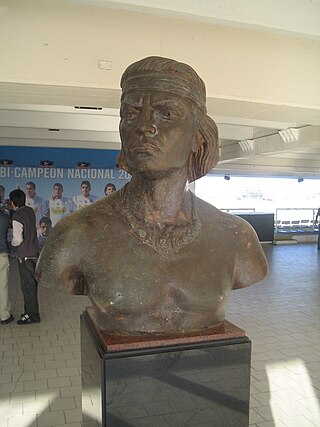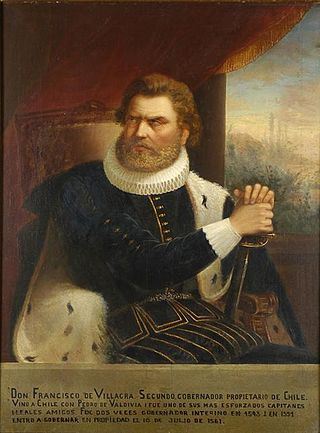Related Research Articles

Pedro Gutiérrez de Valdivia or Valdiva was a Spanish conquistador and the first royal governor of Chile. After serving with the Spanish army in Italy and Flanders, he was sent to South America in 1534, where he served as lieutenant under Francisco Pizarro in Peru, acting as his second in command.

Colocolo was a Mapuche leader in the early period of the Arauco War. He was a major figure in Alonso de Ercilla y Zúñiga's epic poem La Araucana, about the early Arauco War. In the poem he was the one that proposed the contest between the rival candidates for Toqui that resulted in the choice of Caupolicán. As a historical figure there are some few contemporary details about him. Stories of his life were written long after his lifetime and display many points of dubious historical accuracy.

Caupolicán was a toqui or war leader of the Mapuche people, who led the resistance of his people against the Spanish Conquistadors who invaded the territory of today's Chile during the sixteenth century. His rule as Toqui lasted roughly from 1553-1558 AD.

Toqui is a title conferred by the Mapuche on those chosen as leaders during times of war. The toqui is chosen in an assembly or parliament (coyag) of the chieftains (loncos) of various clans (Rehues) or confederation of clans (Aillarehues), allied during the war at hand. The toqui commanded strict obedience of all the warriors and their loncos during the war, would organize them into units and appoint leaders over them. This command would continue until the toqui was killed, abdicated (Cayancaru), was deposed in another parliament, or upon completion of the war for which he was chosen.

Francisco de Villagra Velázquez was a Spanish conquistador, and three times governor of Chile.

The Battle of Tucapel is the name given to a battle fought between Spanish conquistador forces led by Pedro de Valdivia and Mapuche (Araucanian) Indians under Lautaro that took place at Tucapel, Chile on December 25, 1553. This battle happened in the context of the first stage of the Arauco War, named the "offensive war" within a larger uprising by Araucanians against the Spanish conquest of Chile. It was a defeat for the Spaniards, resulting in the capture and eventual death of Valdivia.

Francisco de Aguirre was a Spanish conquistador who participated in the conquest of Peru, Bolivia, Chile and Argentina.
Battle of Peteroa was a battle in the Arauco War in 1556, in a plain beside a river in the Mataquito River valley, called Peteroa. The battle was between the Spanish forces of Pedro de Villagra, and Mapuche headed by their toqui Lautaro.
Ainavillo, Aynabillo, Aillavilu or Aillavilú, was the toqui of the Mapuche army from the provinces of "Ñuble, Itata, Renoguelen, Guachimavida, Marcande, Gualqui, Penco and Talcahuano." They tried to stop Pedro de Valdivia from invading their lands in 1550. He led about twenty thousand warriors in the surprise night attack on Valdivia's camp in the Battle of Andalien. After his defeat in that battle he gathered more warriors from the allied regions of Arauco and Tucapel, south of the Bio-Bio River, for an attack on Valdivia's newly constructed fort of Concepcion at what is now Penco. Leading an army of sixty thousand warriors in three divisions against the fort in the Battle of Penco. Ainavillo's command that had been previously defeated at Andalien, was recognized by the Spaniards and Valdivia picked it out for a vigorous charge by all their cavalry following a softening up by volleys of their firearms. It was broken at the first onslaught and fled with the Spanish in pursuit, followed by the retreat of the other two divisions of the Mapuche upon seeing the spectacle.
The Battle of Andalien, fought in early February 1550, was a night battle between 20,000 Mapuche under the command of their Toqui Ainavillo and Pedro de Valdivia's army of 200 Spanish soldiers and cavalry with a large number of yanakuna, including 300 Mapochoes auxiliaries under their leader Michimalonco.
Battle of Quilacura took place during the Arauco War, fought at night, four leagues from the Bio-Bio River, between the Spanish expedition of Pedro de Valdivia and a force of Mapuche warriors led by Malloquete on February 11, 1546.
The Battle of Penco took place on March 12, 1550, between 60,000 Mapuche under the command of their toqui Ainavillo with his Araucan and Tucapel allies and Pedro de Valdivia's 200 Spaniards on horse and afoot with many yanakuna including 300 Mapochoes auxiliaries under their leader Michimalonco, defending their newly raised fort at Penco. It was part of the Arauco war.
Jerónimo de Vivar was a Spanish historian of the early conquest and settlement of the Kingdom of Chile, and author of Crónica y relación copiosa y verdadera de los reinos de Chile.
The Battle of Mataquito was fought in the Arauco War on April 30, 1557, between the forces of the Spanish governor, Francisco de Villagra, and Mapuche headed by their toqui Lautaro. It was a surprise attack, carried out at dawn, on Lautaro's fortified camp between a wooded mountain and the shore of the Mataquito River. The battle is notable for ending Mapuche designs on Santiago, while also avenging the death of former governor Pedro de Valdivia, who had been killed by Lautaro's warriors four years earlier.
Peteroa is a small town west southwest of the town of Sagrada Familia, Chile.
Juan Godíñez Conquistador Juan Godínez, was born in the city of Úbeda, Spain. He came to the Americas in 1532. After coming to Peru, he campaigned with Diego de Almagro in Chile. He later served in Peru in the subjugation of Manco Inca, and in the expeditions of the captains Pedro de Candia and Diego de Rojas. Afterward, he returned to Chile in 1540 with Pedro de Valdivia serving in the wars of the Conquest of Chile until the arrival of García Hurtado de Mendoza.
Andalicán during the era of conquest and colonial times in Chile was the name of the high hill in the middle of two ravines and site of a fortress built by the Mapuche in 1557 to prevent García Hurtado de Mendoza from invading La Araucanía north of Marihueñu and the valley of Colcura. This height overlooks the location of the modern city of Lota in Concepción Province of the Bío Bío Region of Chile.
The Battle of Millarapue that occurred November 30, 1557 was intended by the Toqui Caupolicán as a Mapuche ambush of the Spanish army of García Hurtado de Mendoza that resulted in a Spanish victory when the ambush failed.
The Battle of Lagunillas was a battle in the Arauco War on November 8, 1557, between the army of García Hurtado de Mendoza and the Mapuche army near some shallow lakes a league south of the Bio-Bio River.

Battle of Quiapo in the Arauco War was the final battle in the campaign of García Hurtado de Mendoza against the Mapuche under the toqui known as Lemucaguin or Caupolicán the younger. It was fought in Quiapo, in the region nowadays known as Arauco Province, Chile on December 13, 1558. The importance of this battle was the first time that the Mapuche fought using a squad that carried firearms.
References
- ↑ Jerónimo de Vivar, Crónica y relación copiosa y verdadera de los reinos de Chile, Capítulo LXVI
